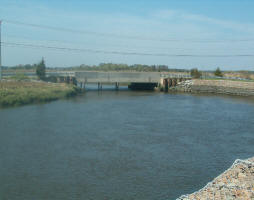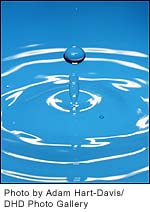 Water Scarcity: A Daunting Challenge with a Hopeful Future
Water Scarcity: A Daunting Challenge with a Hopeful Future
At the very least, 2012 has been a challenging year for Spain, whose economy continues to suffer due to ongoing fallout from the financial crisis. While the country's construction industry has been at the heart of this crisis -- contributing to, and weighed down by, the bursting of the real estate bubble -- few people know that Spain's construction businesses are responsible for some of the world's most advanced water-treatment strategies and technologies.
The Global Water Industry
In 2011, Global Water Intelligence estimated a global market size of US$316 billion, of which approximately US$203 billion is accounted for by industrial and utility water-related expenditures, (excluding energy and labor). The water market can be subdivided into several distinct components.
First, waterworks companies provide water and wastewater utility services (e.g., water utilities, wastewater/sewer utilities and regulated and utilities services). Second, water-technology and infrastructure companies provide products and services that support municipal water and wastewater utilities, industrial customers and residential water treatment. These first two categories combined account for about 50% of water revenue, according to Snet Global Water Indexes. Third are the providers of technical equipment (21%), ranging from basic infrastructure (e.g., pumps, pipes and valves) to measurement (e.g., meters) and treatment (e.g., chemicals, activated carbon and ion exchange). And finally there are the service providers (26%), from engineering and construction to consulting, drilling, water-rights trading and storage and bottled water.
In addition to France's Veolia and Suez, the global water-services market is dominated by Spanish companies, including Acciona Agua, Sacyr/Valoriza, Aqualia, Cadagua, Cobra and Tecnicas Reunidas. Spain's leadership in global water dates back to the 1970s, when the government and large infrastructure companies "bet on membranes," as Alejandro Jiménez, commercial director of services for Acciona Agua, noted. At a time when the global-water sector was still focused on basic exploration of ground and surface waters and energy-inefficient treatment of wastewaters, these firms were investing heavily in early osmosis desalination technologies that would prove to be pioneering. These technologies today are used in 70% to 80% of existing desalination capacity and close to 100% of new projects.
The reason for this innovating move can be found in Spain's own complicated water landscape. The northern regions -- such as the Basque country, Galicia and Asturias -- have a temperate climate with abundant rainfall and fresh water. On the other hand, the center and south of the country are arid regions, suffering from frequent droughts. Furthermore, the explosive growth of tourism in the coastal regions and the Balearic and Canary Islands increased demand significantly for fresh-water resources in these areas. Because transporting water from the north to the disparate dry regions was out of the question in most cases, generation of "new" fresh water through desalination became a clear priority for Spain.
The substantial investments in desalination and wastewater-treatment technologies, and the osmosis membranes that followed, have lowered the fixed and variable costs of water generation over time. Thus, these technologies are employed widely today and have the potential to mitigate future water shortages. According to research estimates, by 2025, desalination will account for 11.5% of water generation compared with an installed capacity of only 1% in 2007. This will require important infrastructure investment projects, both public and private, as reflected in the Millennium Development Goals (MDG), which foresee US$280 billion in public-water infrastructure spending.
Private water-service providers, such as the Spanish infrastructure companies or France's Veolia and Suez, project annual spending of approximately US$37 billion in Asia, US$25 billion in Europe (both up from US$15 billion in 2010) and US$18 billion in the rest of the world (up from US$7 billion) by 2016. Spanish infrastructure companies are well placed to take advantage of these developments.
The Spanish companies have been keen to develop business abroad, driven by the flagging economy at home where they have suffered from the collapse of the construction boom, the resulting downturn in new business for water operators and managers, and a deterioration in desalination margins. A recent list of prequalified bidders for a prestigious project in Ghubrah, Oman, was almost exclusively Spanish, even as the Middle Eastern market had previously been the domain of the French environmental infrastructure heavyweights, Veolia and Suez. Jiménez commented that the Middle East was a growing focus for the company but that it was also winning concessions in other parts of the world.
Given the relative cultural and linguistic proximity, South America, in particular, is looking to become a strong market for Spain's water firms. Sacyr will build its first desalination plant in the sub-continent for mining company Mantoverde in Chile. At the same time, Acciona has been active in the region for several years, constructing Venezuela's first reverse-osmosis desalination plant, carrying out a technical-support and maintenance contract for the Arrudas WWTP in Brazil and constructing the Peravia drinking-water plant in the Dominican Republic and a water-treatment plant in Colombia, among other projects.
Water Scarcity -- a 21st-century Problem
Economists agree that one of the most critical examples of price variation for a specific product occurs when the product suffers from an imbalance between its supply and demand. What is not so evident, however, is the fact that, due to continuous population growth, contamination of sources and inefficient utilization of available resources, water -- perhaps the most important resource for mankind -- is facing an ever-increasing supply/demand imbalance.
It is important to note that increasing demand is not the only explanation for water scarcity around the world. According to the United Nations (UN), there is enough fresh water on the planet for six billion people. However, this water is distributed unevenly, and too much is wasted, polluted or managed unsustainably. Although there is no global water scarcity as such, an increasing number of regions are chronically short of this critical resource.
The problem of uneven distribution becomes obvious when we compare countries rich in water sources (such as Colombia and Canada) to areas suffering from severe scarcity (such as North Africa and the Middle East). According to the UN, approximately 1.2 billion people (or nearly a fifth of the world's population) live in areas of physical scarcity, and another 500 million are approaching this situation. Projections show that, by 2025, 1.8 billion people will be living in countries or regions with absolute water scarcity, and two-thirds of the world's population could be living under water-stressed conditions.
The problem of water being wasted, polluted or managed unsustainably has become a serious issue in the last century, as water use has been growing at more than twice the rate of the increase in population. The UN estimates that water production lost due to leakage, theft and inadequate billing practices ranges from 10% to 30% in developed nations and from 40% to 50% in developing countries. By 2050, untreated wastewater could contaminate a third of global annual renewable freshwater supplies. Including those who currently do not live in areas of physical scarcity, 1.6 billion people face economic water shortages, where countries lack the necessary infrastructure to make water from rivers and aquifers accessible. At the same time, agriculture alone utilizes 15% to 35% of its water in excess of sustainable limits.
According to Jiménez, agriculture illustrates the classic case of water mismanagement, where potable water is often used for purposes that could be served by other types of "reutilized" water, preserving the premium water for more vital purposes (i.e., for drinking or personal hygiene). This problem extends beyond agriculture, given that many parts of the world use the same premium, potable water from the faucet to flush toilets.
Finally, there is also a growing need for investment in infrastructure to deliver water to the end users and to transport wastewater back to treatment plants. The vast network of pipes in developed countries is deteriorating quickly and is in urgent need of repair. The situation is even worse in the developing world, where basic infrastructure is still lacking, particularly for wastewater treatment. In many parts of the world, poor urban residents still buy water from trucks because there is no piped tap water for their homes. Jiménez stated that people often do not realize how costly it is to bring water to their taps and that the prices they pay in water tariffs do not reflect the full costs associated with the processes.
Water scarcity is a complex and challenging problem, especially in light of ever-increasing global demands. Jiménez, however, pointed to the continuous investment in searching for new sources of water, such as desalination technologies, as one of the few foreseeable solutions.
Technology May Save the Day
Population growth, urbanization, agriculture and climate change will continue to strain fresh-water resources and serve to make the global need for water-treatment technologies ever more urgent. Desalination -- that is, any of several processes that remove salt and other minerals from saline water -- plays a critical role in addressing both short- and long-term water-supply shortages. Current desalination technologies can be grouped into three main categories: membrane, thermal and other.
The predominant technologies are reverse osmosis (a membrane technology), multi-stage flash and multi-effect distillations (both thermal technologies). Reverse osmosis (RO) is a membrane-filtration technique. The thin, selective barrier allows water molecules through, but not the salt and mineral molecules. Multi-stage flash (MSF) is a water-desalination process that distills seawater by flashing a portion of the water into steam in multiple "stages" -- i.e., spaces utilizing varying temperatures and pressure points to optimize evaporation of the salt. Multi-effect distillation (MED) also utilizes multiple stages where the feed water is heated by steam in tubes. Some of the water evaporates, and this steam flows into the tubes of the next stage, heating and evaporating more water. As of 2009, RO provided 53% of global desalination capacity, while MSF and MED provided 25% and 8%, respectively. To give some perspective to the cost variance across these technologies, the cost of water per cubic meter is US$.90-US$1.50 for MSF-treated water, ~US$1.00 for MED-treated water, US$.99 for RO-treated seawater and US$.20-US$.70 for RO-treated brackish water.
Though these technologies are quite effective and beneficial, they also have some challenges that can make them prohibitive, which include high energy usage, related CO2 emissions due to the power supply, and contamination of and damage to the aquatic ecosystem. High energy usage occurs both on and off the grid, but is especially high in island systems where all the fuel used also needs to be transported to the site. Contamination of and damage to the aquatic ecosystem can be caused by high temperatures used in some of the technologies, uncontrolled salt content as a by-product of the treatments, pretreatment chemicals and contaminants stemming from the use of nuclear power.
The challenges outlined are significant, but perhaps the most palpable and daunting are the many high costs associated with desalination technologies. These costs come from a variety of sources, including upfront capital costs, energy costs, operation and maintenance, and cost of water at its source. Once the water is treated, additional costs arise from creating the infrastructure to transfer this resource from the point of treatment to the point of use. Finally, where existing infrastructure is used, loss during water transfer, due to seepage and leaky pipes, creates a great deal of waste as very expensive desalinated water is lost even before reaching its destination. Because of high upfront capital costs and continued operating expenses, the bulk of the global desalination plants and infrastructure tend to be in high-income economies such as the Middle East and the U.S.
While these technologies are effectively desalinating water in various parts of the world, innovation is required to make them more cost-effective and accessible in remote areas that have the greatest potable water needs. One such innovation is reducing dependence on finite energy resources and focusing on usage of renewable energy sources, especially in remote coastal and island regions -- a concept known as "renewable integration."
Another area of innovation that leverages this integration focuses on aiding remote regions through the design of mobile and modular desalination systems. These smaller systems are easy to transport and assemble and can support the generation of potable water for consumption and sanitation in remote locations in addition to small-scale industrial operations. If these deployments were expanded to scale, they would help the technology move down the experience curve, increase adoption rates, lead to further innovation and ultimately help to reduce the costs of desalination technology across more and wider areas.
Continued R&D is critical for the innovation needed to provide one of the planet's most basic resources to its ever-growing population. Fortunately, certain factors are making it easier to provide justification for and secure funding -- e.g., increased awareness of the importance of renewable energy, increased flexibility around modularity or centralization of water supplies and a better understanding of the environmental impact of desalination technologies.
Challenge and Opportunity for Water Industry Leaders
As noted above, "the water problem" is multi-faceted and complex. Desalination technologies play a major role in addressing the treatment of water, but significant challenges remain for them to begin to counterbalance the growing need for this critical resource. Additional significant investment is needed to produce the necessary innovations for sustainability. The Spanish water-industry leaders have proven their expertise and abilities to push the technological and thought boundaries of their industry and are in a unique position to guide how we manage this vital resource.
| Contact information |
This article was written by Azita Habibi, Rodrigo Sabato and Pia Schaefer, members of the Lauder Class of 2014.
|
|---|---|
| News type | Inbrief |
| File link |
http://knowledge.wharton.upenn.edu/article.cfm?articleid=3164 |
| Source of information | Knowledge@Wharton |
| Keyword(s) | water scarcity, desalination, osmosis |
| Subject(s) | AGRICULTURE , ANALYSIS AND TESTS , CHARACTERISTICAL PARAMETERS OF WATERS AND SLUDGES , DRINKING WATER , DRINKING WATER AND SANITATION : COMMON PROCESSES OF PURIFICATION AND TREATMENT , ENERGY , FINANCE-ECONOMY , HYDRAULICS - HYDROLOGY , INDUSTRY , MEASUREMENTS AND INSTRUMENTATION , METHTODOLOGY - STATISTICS - DECISION AID , NATURAL MEDIUM , POLICY-WATER POLICY AND WATER MANAGEMENT , PREVENTION AND NUISANCES POLLUTION , RISKS AND CLIMATOLOGY , SANITATION -STRICT PURIFICATION PROCESSES , TOURISM - SPORT - HOBBIES , WATER DEMAND , WATER QUALITY |
| Relation | http://www.guardian.co.uk/sustainable-business/water-scarcity-san-joaquin-valley |
| Geographical coverage | Spain, |
| News date | 03/01/2013 |
| Working language(s) | ENGLISH |
 you are not logged in
you are not logged in





